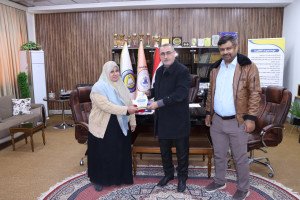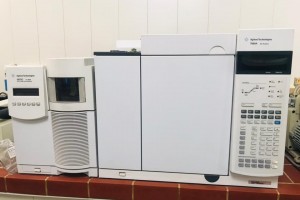
The College of Education for Pure Sciences in the Department of Life Sciences discussed a doctoral thesis on (isolating and identifying some blue-green algae from different environments and demonstrating their ability to produce hepatotoxins)
The thesis presented by the researcher (Mustafa Taher Hatem) included a study on the phenotypic and molecular diagnosis of five types of blue-green algae, Cyanophyta, from some water bodies in Basrah Governorate, and their isolation, purification, and propagation. Three of them were diagnosed for the first time locally, which were represented by the species Chroococcidiopsis cubana, Leptolyngbya halophila, and Oscillatoriales cyanobacterium, as well as About the alga, Cyanobacterium aponinum. As for the fifth alga, Gloeocapsa calcarea, the sequence of its nitrogenous bases of the 16S rRNA gene was recorded for the first time in the world in GenBank on the website of the National Center for Biotechnology Information (NCPI), and the isolated strains were given accession numbers. The following are OR269467, OR269464, OR269465, OR269463 and OR269466 respectively.
A phylogenetic tree was designed for the isolated strains based on the 16S rRNA gene sequence, as the tree showed that the isolated strains are closely related to the close reference strains for each species.
He drew the growth curve for the five isolated and purified species after growing them in BG-11 liquid culture media, and measured the growth constant (k) and the generation time (G) for the isolated species.
The ability of the species isolated in the study to produce hepatotoxins (MCs) Microcystins was tested. These toxins were isolated and characterized quantitatively and qualitatively using two techniques: the first was High Performance Liquid Chromatography (HPLC) and the second was the use of Enzyme Linked Immuno Sorbent. Assay (ELISA). The study also aimed to use the polymerase chain reaction (PCR) as an accurate and rapid method for detecting toxin-producing blue-green algae based on the presence of the genes that build the hepatic toxin Microcystin synthetase, represented by the mcyA gene and the mcyE gene.
Quantitative Polymerase Chain Reaction (qPCR) technology was also used to compare the rates of the number of cycles needed to cross the threshold line (Ct Value Cycle of threshold) and give a signal fluorescence signal from the DNA resulting from the amplification of the mcyA gene for each type of isolated blue-green algae. Purified, biomass and aquatic environment.
The thesis analysis of the sequences of the nitrogenous bases of the species isolated in the current study concluded that there are several types of point mutations in the amplified region of the 16S rRNA gene when compared with the reference strains, represented by unequal base substitution mutations, Transversion, Transition, deletion mutations, and insect mutations.









